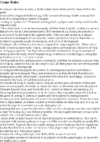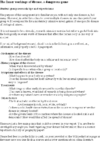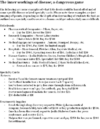Disease, a dangerous game
Biology in Middle Schools home | |Elementary School sister project
Biology In Middle Schools is a Saint Michael's College student project. Link under 'toolbox' for a printer-friendly version. Click on handouts to print full resolution versions. Please see Wikieducator's disclaimer, our safety statement, and the Creative Commons licensing in English and in legalese.
Primary biological content area covered
- Disease on a cellular, molecular, public health and pharmacology level
- Link and expand the connection to cellular biology/AIDs unit already established
- Bridge life cycles of parasitic, cellular working of genetic, and environmental factors of any disease chosen
- Role of human immune system in fighting off disease
- Molecular/cellular aspects of immunology
- Drug therapy
Additional non-biological content area covered
- Socioeconomic factors associated with disease
- Current "hot topics" associated with multiple aspects of disease
Materials
Safety equipment
- No specific safety equipment is needed. Be sure to monitor younger students if they assist in the construction of the game boards as scissors will be used.
Teacher's Materials
- Blank poster board or cardboard. Approximately 20'x20'
- Black, Yellow, Red, Orange, Pink, Light Blue, Purple, Blue and Green permanent markers
- 2 rolling dice
- Glue sticks
- Ruler
- Necklace beads, beans or substitute (32 houses/12 hotels)
- Player identification pieces( Lego's, coins, Etc.) 6 total
- Play money in the following denominations:
- (20) $500, (20) $100, (30) $50, (50) $20, (40) $10, (40) $5, (40) $1 bills
- Scissors
- Related disease/disorder pictures to decorate board
- Approximately 200 blank index cards/thick stock paper ("bonus" and "deeds" cards)
- Lamination clear plastic material (to ensure longevity of completed projects)
Student materials
- If students are expected to help construct the games teachers should provide materials. Other than that all students need is an open mind!
Handouts
Click the thumbnail to the right to access rules and a student activity guide
Description of activity
In this hands on activity students will design, present, and play a board game based loosely off Parker Bros. Monopoly and centered off a disease or disorder relating to their biology curriculum. The board game will closely imitate the Monopoly style of play. The level of difficulty of the game depends on the subject matter chosen by the teacher and the depth of student research, but the intent is for the game to be very "playable" and for students to learn as they play. Our vision is that of a 1st person experience of each player having to deal with every imaginable aspect of a chosen disease.
It is recommended that students be broken down into teams of 4-5 and each assigned a biologically interesting disease or disorder. Then, using this Wiki page as a guide, research, design, and create a game that can be presented to the class and played by classmates with similar basic understanding of biological systems and processes.
Lesson plan
Title of lesson
- The Inner workings of disease, a dangerous game
Length of game
- Length of game varies upon style of play, but can be limited to an ideal 30-45 minute class period if the rules are modified.
Age/Grade level
- Can be adapted for 6th through 8th grade
Teacher Content Knowledge
- Instructor needs to have a working knowledge of cellular biology and immunology. Knowledge of the specific diseases assigned to students would be advisable in order to proof read and grade appropriately.
Rationale and context
- Student groups will be given the opportunity to perform independent research on an assigned biologically interesting disease or disorder.
- Groups will then be expected to apply that knowledge to design and create a game in order to enlighten others. Along with the actual board game students will be expected to prepare a short presentation of their assigned disease.
- Student groups will then have an opportunity to switch games and cement knowledge gained from previous student presentations by engaging in an interactive, hands on board game created by students for students.
Essential question
- How and why do diseases effect the human body?
Focusing question
- While incorporating non-biological aspects such as the specific disease's history and socioeconomic factors, how do people live and die of each specific disease and what can be done to change those factors?
- Students are grouped in teams of 4-5 and given an assigned disease. Relatively well known, and biologically interesting diseases, such as AIDs, Malaria, and Diabetes are a start. But any biologically related topic would work (i.e. Drug dependency and treatment or specific genetic disorders)
- Students are asked to research their disease as a team and provide a written report of the history, origin, cellular/molecular mechanism, treatment, related drugs and other non-biological topics related to the disease. This will provide a background for creating the game. (Fig. 2) provides a rough template of what students should be researching.
- It is also possible for a group to produce independent reports on the same disease if enough classroom time cannot be allotted for group research.
- Once the reports are graded, the student groups are then tasked to create a board game for other student groups to play. Materials will need to be passed out and adequate time balloted for the completion of this some what complex construction phase. It is possible to allow group members to divide and work on the assignment at home but regular, short, group meetings should be allowed in class followed by adequate clean up time following construction.
- In a 4-5 person group a conservative estimate of 20-30 minutes per night, per group member for approximately 4 days should be enough to rapidly develop the board game. Followed by daily 15-20 minute group work sessions to put the individual pieces together.
- Upon completion the class can meet as a group and individuals can present their board games, making sure to note any significant deviations from basic Monopoly style of play. The teams can then switch board games and play each others games.
- In theory this could be a multi-part 2 week assignment. With the paper taking 3-4 days of the first week and the project occupying the next 4 days and the presentations and playing of the games taking the last 2-3 days.
- It could be treated as an intensive in class group project or as more of an independent research project with a final group project as a capstone.
Potential pitfalls
Designing the board game will take a moderate amount of materials and time but it should be looked at as a permanent teaching tool once completed that can be reused and improved upon. Keeping students on track within a given time frame will be important as there are an infinite number of directions they can go with project designs and ideas. Keep it simple and don't let the students get stuck in the mud over small details.
Math connections
While the game does integrate basic math skills in the ability to calculate change and buy and sell property there is additional opportunity to incorporate math into the game as "bonus questions". For example, calculating the drip rate of an I.V. medication could earn a player $200 dollars. Or a player may have to solve a basic math problem pertaining to profit vs. cost of distribution of a drug in a 3rd world country.
Literature connections
- Disease Database [[1]]
- If the disease your looking for isn't in here you probably just discovered it...
- Skin Disease Database [[2]]
- Great reference for skin diseases
- National Organization For Rare Disorders[[3]]
- Karolinska Institutet Disease Links [[4]]
- Multitude of links and back ground information
- The Collaborative on Health and the Environment Toxicant and Disease Database [[5]]
- U.S. Center for Disease Control[[6]]
- Great starting point for general information on disease
- Duke University Library Literature Cited Reference [[7]]
- If its someone else's idea dont forget to give them credit for it!
- Vermont Peace and Justice Center [[8]]
- Good jumping off point for socio-economic factors of the report/board game
- Dr. Fighting for better health care in the 3rd world [[9]]
- Interesting article on the underlying non-biological aspect of this activity
Connections to educational standards
This activity was tailored to expand on the Mater Christi unit on disease. As the only specific disease studied was AIDs the goal of this activity is to expand the opportunity of analysis of more diseases of varying type and nature.
This activity fits in with CS #4 and #5. Also, this is a moderately intensive research project that can introduce or strengthen students ability to conduct independent research and to properly cite resources used.
[[10]]
Citations and links
While brand new ideas are very valuable and most welcome here, tried and trusted ideas of others will probably make up the bulk of the material on this site. It is important to respect the copyrights of others, and also to acknowledge their ideas. A full citation to published materials is essential and also useful. If there are online materials that would be useful to supplement your program, link to them from here. The inner workings of disease; a dangerous game/Background
| Work in progress, expect frequent changes. Help and feedback is welcome. See discussion page. |






